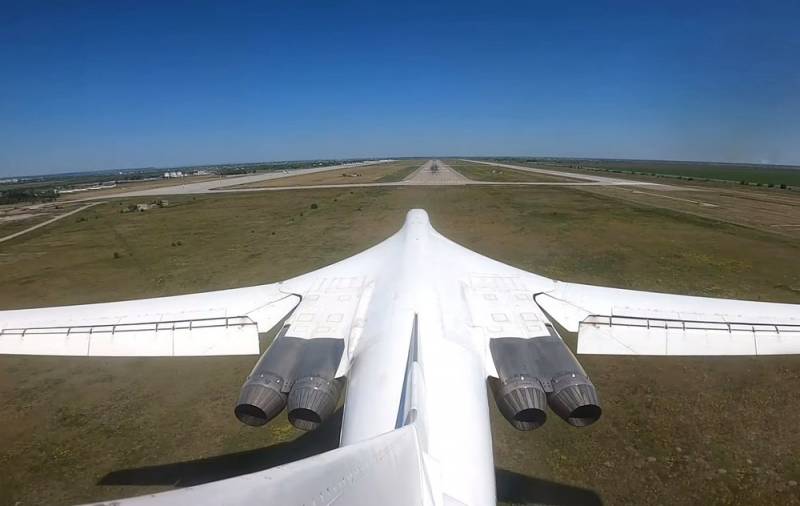How Tu-160M can help in the revival of the Naval Aviation of the Russian Navy
By the end of 2021, the newest Russian supersonic strategic missile carrier Tu-160M will pass flight tests. Unlike its counterparts in Long-Range Aviation, this is a "remake", an aircraft created from scratch according to a modernized project, with improved engines. The successful launch of the updated "White Swans" into the series opens up a lot of interesting opportunities for the Ministry of Defense of the Russian Federation.
The Tu-160 was developed in the USSR as a response to the American strategic missile carrier Rockwell B-1 Lancer. Subsonic bombers Tu-95 and M-4 could not effectively overcome the NATO air defense system. The Soviet command needed a multi-mode aircraft capable of approaching the target at subsonic cruising speed, overcoming enemy air defenses at supersonic speed at high altitude or at cruising near the ground, shooting back and leaving swiftly. As a result of the work of our designers, a unique supersonic strategic missile carrier appeared, the fastest and most lifting of all those in service. The White Swan has set 46 world records. Tu-160 is an integral part of the Russian "nuclear triad" as part of Long-Range Aviation. Also, bombers successfully performed combat missions as part of the participation of the Russian Aerospace Forces in the Syrian campaign.
Yes, we really have something to be proud of. However, after the collapse of the USSR and all kinds of "optimizations", less than two dozen "White Swans" remained in the ranks. In 2015, Russian Defense Minister Sergei Shoigu announced the need to resume production of the Tu-160 in version M (modernized). The next year, 2016, at the Kazan Aircraft Building Plant, work began to restore the serial production of White Swans. It was announced that the Ministry of Defense will purchase a batch of 50 Tu-160M bombers. At the same time, the existing missile carriers are also subject to deep modernization.
What changes and improvements will affect our "strategists"?
At first, this is a new power plant, the NK-32-02 turbojet engine. In 2016, Kuznetsov PJSC resumed the production of this power plant, carrying out work on its deep modernization. Thanks to this, the Tu-160M will now be able to maintain a supersonic speed of about two Mach numbers for 45 minutes, and the combat radius has increased by 1 thousand kilometers. Last year, the Russian engine even received unexpected praise from the specialized American publication Aviation Week & Space Technology for its achievements in the field of global engine building:
The redesigned compressor and turbine blades, together with improved cooling, have increased the fuel efficiency of the turbojet by-pass engine, capable of operating in afterburner mode.
Not bad for a gas station country “incapable of designing an electric kettle,” as Western propagandists assure us.
SecondlyUnlike the original Tu-160, designed to deliver nuclear strikes, modern aircraft are truly multifunctional, as has been demonstrated in Syria. "White Swans" can carry long and medium-range cruise missiles, including those without a nuclear warhead, as well as free-falling aerial bombs, which allows them to be used as Moscow's "distant hand" in conventional medium-intensity conflicts.
Thirdly, Tu-160M received modern avionics, the latest digital control systems, a convenient sighting and navigation device. The size of the plane allows pilots to even walk on it to stretch their legs on a long flight, heat food in the microwave, etc.
Thus, the revived "White Swan" will significantly expand the capabilities of the RF Ministry of Defense in the field of "nuclear deterrence", as well as the use of long-range aviation in non-nuclear armed conflicts. It is very pleasing that the military will eventually receive 50 such bombers that are unique in terms of tactical and technical characteristics, since this will make it possible to rotate between Long-Range and Naval Aviation.
A while ago we complained about the systemic problems faced by the Naval Aviation of the Russian Navy, which is in a real crisis: this is the shortage of aircraft, and the obsolescence of the aircraft fleet, which is a huge problem in relation to anti-submarine aviation, etc. It should be noted that in 2011 the Russian Navy's naval missile-carrying aviation was generally eliminated as a class. This is exactly the one that was supposed to fight the enemy's AUG due to the lack of its own aircraft carriers. So, it has not existed for 10 years already, and all of its Tu-22M supersonic missile-carrying bombers were transferred to the Long-Range Aviation.
Good news lies in the fact that in the very near future Long-Range Aviation will begin to replenish with brand new strategic bombers Tu-160M. This will free up the Tu-22M and revive the Naval Missile Aviation, the need for which is beyond the slightest doubt. In addition, it might be advisable to strengthen the MPA with a dozen White Swans. One Tu-160M is capable of receiving up to 3 hypersonic Dagger missiles. Provided that it is accompanied by MiG-31 supersonic fighters, having received reliable data for target designation, a strategic missile carrier approaching the target with afterburner will turn into a real thunderstorm for the US Navy AUG.

Information